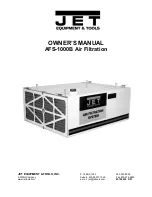
12
If tower is equipped with a two-speed motor, check for proper rota-
tion at both speeds. Check also to see that starter is equipped with a
20 second time delay which prevents direct switching from high
speed to low speed. If the fan is intended to be reversed for deicing
purposes, make sure that the starter is equipped with a 2 minute
time delay between changes of direction. These delays will prevent
abnormal stress from being applied to the mechanical equipment
and the electrical circuit components.
3. Run the motor and observe the operation of the mechanical equipment.
Operation should be stable.
4. Check belt tension and torque on the fan and motor sheave after 10 to
60 hours of operation. See Torque Values on page 25.
If the water supply system is not being operated—or if there is no
heat load on the system—motor amps read at this time may indicate
an apparent overload of as much as 10–20%. This is because of the
increased density of unheated air flowing through the fan. Deter-
mination of an accurate motor load should await the application of
the design heat load.
Tower Startup
Microorganisms including Legionella bacteria can exist in premise
plumbing including cooling towers. The development of an effective
water management plan (WMP) and implementation of maintenance
procedures are essential to prevent the presence, dissemination and
amplification of Legionella bacteria and other waterborne contami-
nants throughout premise plumbing. Before operating the cooling
tower, the water management plan and maintenance procedures
must be in place and regularly practiced.
Water System:
1. Consult a knowledgeable water treatment professional to clean and treat
your new cooling tower prior to startup. Cooling towers must be cleaned
and disinfected regularly in accordance with ASHRAE Standard 188 and
Guideline 12.
2. Do NOT attempt any service unless the fan motor is locked out.
Caution
Note
Warning
installation













































